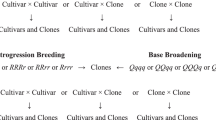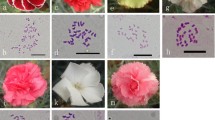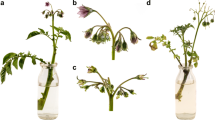Summary
Comparisons were made between tetraploid progenies obtained by crossing dihaploid and chromosome doubled dihaploid potatoes with tetraploids. Dihaploids obtained from a doubled dihaploid produced some progenies from 2xx4x crosses which were as high yielding and had as good tuber characteristics as control progenies produced by intercrossing heterozygous tetraploids. It was found that there was a slight reduction in tuber yield associated with inbreeding but selection could be made among highly inbred material for useful parents.
Other characters were little affected by inbreeding. It was concluded that haploidisation and chromosome doubling could be used to produce homozygous clones for use by breeders without greatly depressing the agronomic value of their offspring.
Similar content being viewed by others
References
De.Maine, M.J., 1982. An evaluation of the use of dihaploids and unreduced gametes in breeding for quantitative resistance to potato pathogens.Journal of Agricultural Science, Cambridge 99: 79–83.
De.Maine, M.J. & J.A. Fantes, 1983. The results of colchicine treatment of dihaploids and their implications regarding the efficiency of chromosome doubling, and potato histogeny.Potato Research 26: 289–294.
De.Maine, M.J. & M.L.M.H. Fleming, 1991. The hybridization of somatically chromosome-doubled dihaploid potatoes with tetraploid cultivars and the use of doubled dihaploids in genetic analysis ofSolanum tuberosum.Annals of Applied Biology 119: 339–347.
De.Maine, M.J. & L. Jervis, 1989. The use of dihaploids in increasing the homozygosity of tetraploid potatoes.Euphytica 44: 37–42.
Falconer, D.S., 1960. Introduction to Quantitative Genetics. Oliver & Boyd, Edinburgh.
Fleming, M.L.M.H., M.J. De.Maine & W. Powell, 1992. Ploidy doubling by callus culture of potato dihaploid leaf explants and the variation in regenerated plants.Annals of Applied Biology 12: 183–188.
Jongedijk, E., 1985. The pattern of megasporogenesis and megagametogenesis in diploidSolanum species hybrids: its relevance to the origin of 2n eggs and the induction of apomixis.Euphytica 34: 599–611.
Mendoza, H.A. & F.L. Haynes, 1973. Some aspects of breeding and inbreeding in potatoes.American Potato Journal 50: 216–222.
Mendiburu, A.O., S.J. Peloquin & D.W.S. Mok, 1974. Potato breeding with haploids and 2n gametes. In: K.J. Kasha (Ed.). Haploids in Higher Plants. University of Guelph Guelph. pp. 249–258.
Yeh, B.P., S.J. Peloquin & R.W. Hougas, 1964. Meiosis in,Solanum tuberosum haploids and haploid-haploid F1 hybrids.Canadian Journal of Genetics & Cytology 6: 393–402.
Author information
Authors and Affiliations
Rights and permissions
About this article
Cite this article
De Maine, M.J. Comparisons of tetraploid progenies of potato dihaploids, their chromosome-doubled derivatives and second generation dihaploids. Potato Res 37, 173–181 (1994). https://doi.org/10.1007/BF02358719
Accepted:
Issue Date:
DOI: https://doi.org/10.1007/BF02358719




